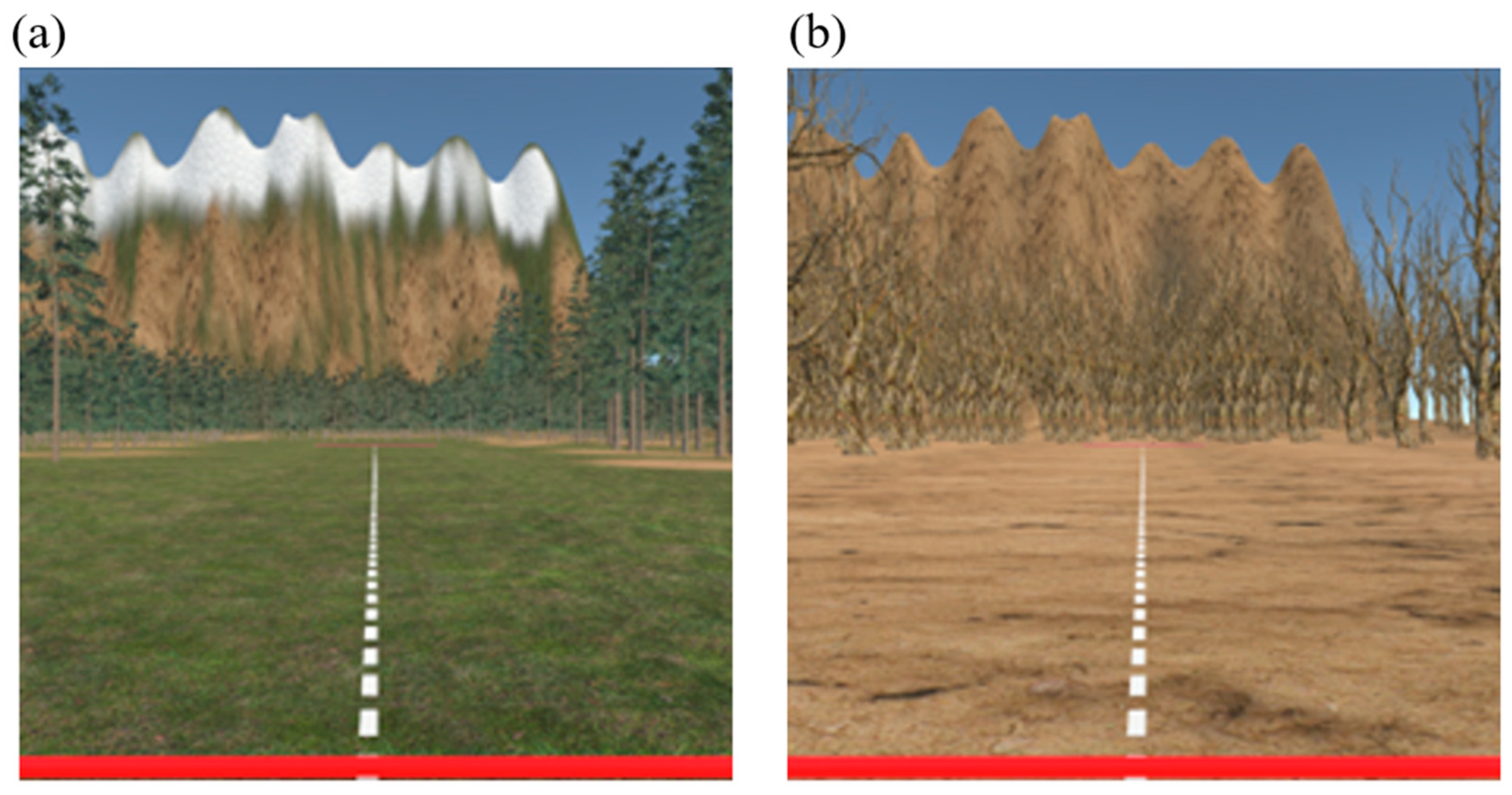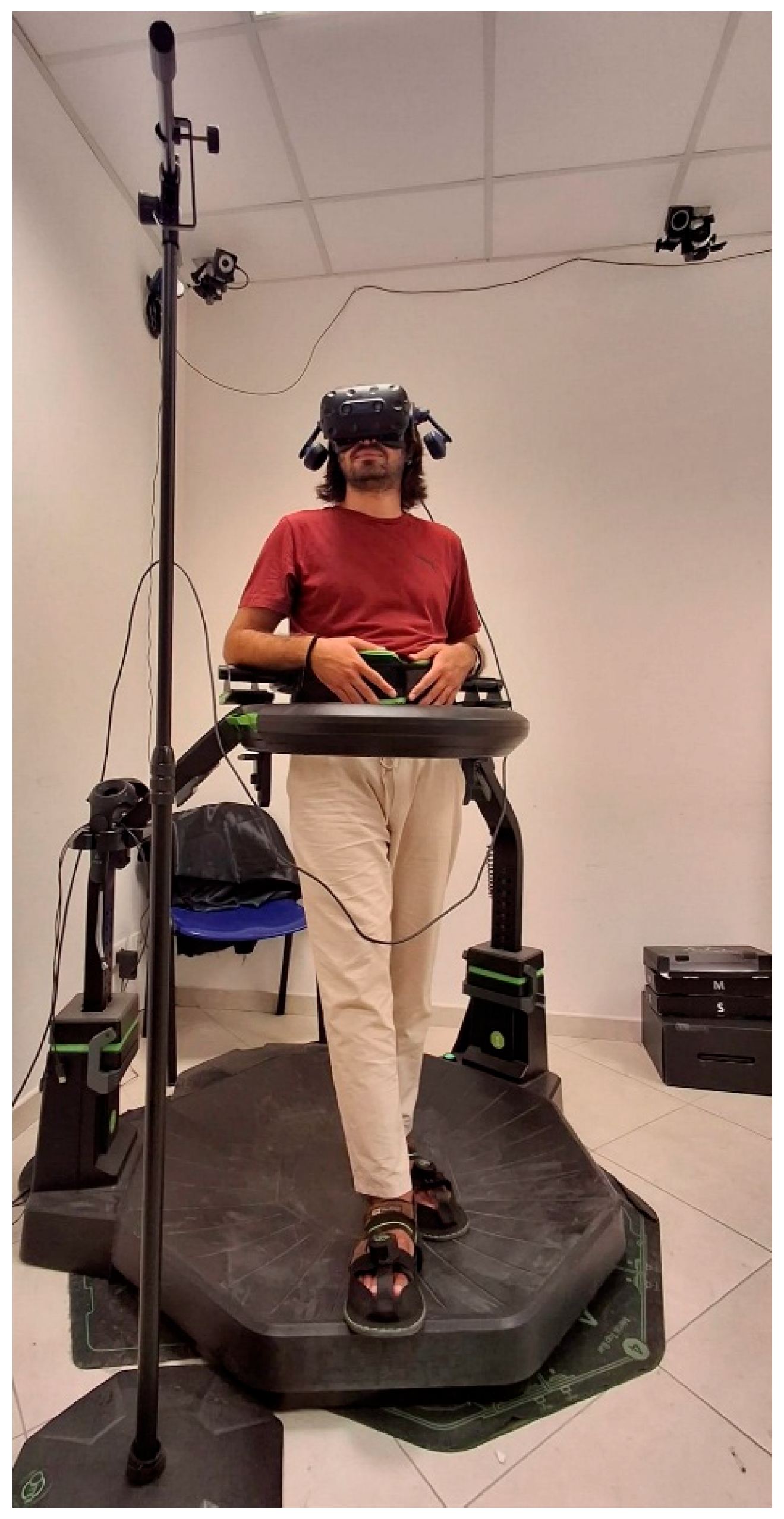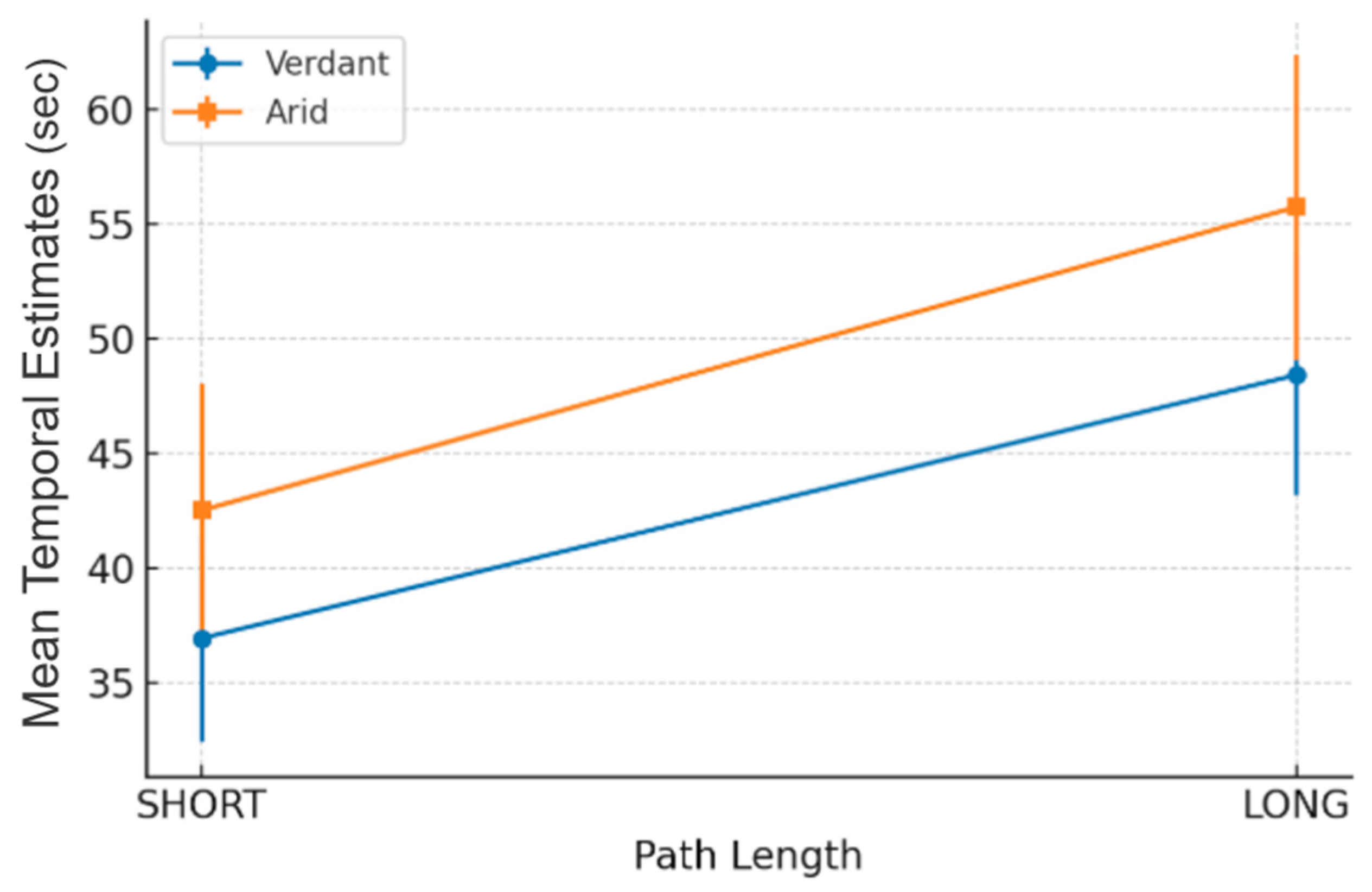Climate-Crisis Landscapes in VR: Effects on Distance and Time Estimation
Abstract
1. Introduction
2. Materials and Methods
2.1. Participants
2.2. Materials
2.3. Procedure
- Immediately after immersion, participants were asked to look around and briefly describe the environment in which they found themselves.
- They were then instructed to walk straight across the entire path, at a self-paced speed, following the dashed line until they reached the arrival marker.
- Once they crossed the arrival line, the scene was paused, and participants were asked to provide a verbal estimate of either the duration of the walk (in seconds) or the length of the path (in meters), depending on the trial type.
2.4. Data Analysis
3. Results
3.1. ANOVA
3.2. Correlations
3.3. Multiple Regressions
4. Discussion
5. Conclusions
Author Contributions
Funding
Institutional Review Board Statement
Informed Consent Statement
Data Availability Statement
Conflicts of Interest
Abbreviations
| VEs | Virtual Environments |
| HMD | Head-mounted display |
| VR | Virtual Reality |
| MAIA | Multidimensional Assessment of Interoceptive Awareness |
References
- World Health Organization. Climate Change and Health. World Health Organization. 2023. Available online: https://www.who.int/news-room/fact-sheets/detail/climate-change-and-health (accessed on 5 September 2025).
- Romanello, M.; Walawender, M.; Hsu, S.C.; Moskeland, A.; Palmeiro-Silva, Y.; Scamman, D.; Ali, Z.; Ameli, N.; Angelova, D.; Ayeb-Karlsson, S.; et al. The 2024 report of the Lancet Countdown on health and climate change: Facing record-breaking threats from delayed action. Lancet 2024, 404, 1847–1896. [Google Scholar] [CrossRef]
- Fletcher, C.; Moirano, G.; Alcayna, T.; Rollock, L.; Van Meerbeeck, C.J.; Mahon, R.; Trotman, A.; Boodram, L.-L.; Browne, T.; Best, S.; et al. Compound and cascading effects of climatic extremes on dengue outbreak risk in the Caribbean: An impact-based modelling framework with long-lag and short-lag interactions. Lancet Planet Health 2025, 9, 101279. [Google Scholar] [CrossRef]
- Schwarz, A.; Béné, C.; Bennett, G.; Boso, D.; Hilly, Z.; Paul, C.; Andrew, N. Vulnerability and resilience of remote rural communities to shocks and global changes: Empirical analysis from Solomon Islands. Glob. Environ. Chang. 2011, 21, 1128–1140. [Google Scholar] [CrossRef]
- Romanello, M.; McGushin, A.; Di Napoli, C.; Drummond, P.; Hughes, N.; Jamart, L.; Watts, N.; Arnell, N.; Ayeb-Karlsson, S.; Ford, L.B.; et al. The 2022 report of the Lancet Countdown on health and climate change: Health at the mercy of fossil fuels. Lancet 2022, 400, 1619–1654. [Google Scholar] [CrossRef]
- Weiskopf, S.R.; Isbell, F.; Arce-Plata, M.I.; Di Marco, M.; Harfoot, M.; Johnson, J.; Lerman, S.B.; Miller, B.W.; Morelli, T.L.; Ferrier, S.; et al. Biodiversity loss reduces global terrestrial carbon storage. Nat. Commun. 2024, 15, 4354. [Google Scholar] [CrossRef]
- Martins, F.P.; Paschoalotto, M.A.C.; Closs, J.; Bukowski, M.; Veras, M.M. The double burden: Climate change challenges health systems. Environ. Health Insights 2024, 18, 11786302241298789. [Google Scholar] [CrossRef]
- Cianconi, P.; Hanife, B.; Grillo, F.; Betro’, S.; Lesmana, C.B.J.; Janiri, L. Eco emotions and psychoterratic syndromes: Reshaping mental health assessment under climate change. YJBM 2023, 96, 211–226. [Google Scholar] [CrossRef] [PubMed]
- Calabria, L.; Marks, E. A scoping review of the impact of eco distress and coping with distress on the mental health experiences of climate scientists. Front. Psychol. 2024, 15, 1351428. [Google Scholar] [CrossRef] [PubMed]
- Cosh, S.M.; Ryan, R.; Fallander, K.; Robinson, K.; Tognela, J.; Tully, P.J.; Lykins, A.D. The relationship between climate change and mental health: A systematic review of the association between eco anxiety, psychological distress, and symptoms of major affective disorders. BMC Psychiatry 2024, 24, 833. [Google Scholar] [CrossRef]
- Wittmann, M. The inner experience of time. Philos. Trans. R. Soc. B 2009, 364, 1955–1967. [Google Scholar] [CrossRef] [PubMed]
- Bellmund, J.L.S.; Gärdenfors, P.; Moser, E.I.; Doeller, C.F. Navigating cognition: Spatial codes for human thinking. Science 2018, 362, eaat6766. [Google Scholar] [CrossRef]
- Peer, M.; Salomon, R.; Goldberg, I.; Blanke, O.; Arzy, S. Brain system for mental orientation in space, time, and person. Proc. Natl. Acad. Sci. USA 2015, 112, 11072–11077. [Google Scholar] [CrossRef]
- Wilson, M. Six views of embodied cognition. Psychon. Bull. Rev. 2002, 9, 625–636. [Google Scholar] [CrossRef]
- Tschacher, W.; Scheier, C. Embodied cognitive science: Concepts, methods and implications for psychology. In Integrative Systems Approaches to Natural and Social Dynamics; Matthies, H., Malchow, H., Kriz, J., Eds.; Springer: Berlin/Heidelberg, Germany, 2001; pp. 551–567. [Google Scholar] [CrossRef]
- Bhalla, M.; Proffitt, D.R. Visual-motor recalibration in geographical slant perception. J. Exp. Psychol. Hum. Percept. Perform. 1999, 25, 1076–1096. [Google Scholar] [CrossRef] [PubMed]
- Miyamoto, Y.; Nisbett, R.E.; Masuda, T. Culture and the physical environment: Holistic versus analytic perceptual affordances. Psychol. Sci. 2006, 17, 113–119. [Google Scholar] [CrossRef] [PubMed]
- Kaplan, S.; Kaplan, R. The Experience of Nature: A Psychological Perspective; Cambridge University Press: Cambridge, UK, 1989. [Google Scholar]
- Hartig, T.; Mang, M.; Evans, G.W. Restorative effects of natural environment experiences. Environ. Behav. 1991, 23, 3–26. [Google Scholar] [CrossRef]
- Bae, C.; Montello, D.; Hegarty, M. Wayfinding in pairs: Comparing the planning and navigation performance of dyads and individuals in a real-world environment. CR PI 2024, 9, 40. [Google Scholar] [CrossRef]
- Spreng, R.N.; Mar, R.A.; Kim, A.S.N. The common neural basis of autobiographical memory, prospection, navigation, theory of mind, and the default mode: A quantitative meta-analysis. J. Cogn. Neurosci. 2009, 21, 489–510. [Google Scholar] [CrossRef]
- Szpunar, K.K.; Spreng, R.N.; Schacter, D.L. A taxonomy of prospection: Introducing an organizational framework for future-oriented cognition. Proc. Natl. Acad. Sci. USA 2014, 111, 18414–18421. [Google Scholar] [CrossRef]
- Montagrin, A.; Morimura, M.; Nadel, L. The hippocampus dissociates present from past and future goals. Nat. Commun. 2024, 15, 2690. [Google Scholar] [CrossRef]
- Proffitt, D.R.; Stefanucci, J.; Banton, T.; Epstein, W. The role of effort in perceiving distance. Psychol. Sci. 2003, 14, 106–112. [Google Scholar] [CrossRef] [PubMed]
- Witt, J.K.; Proffitt, D.R.; Epstein, W. Perceiving distance: A role of effort and intent. Perception 2004, 33, 577–590. [Google Scholar] [CrossRef]
- Riener, C.R.; Stefanucci, J.K.; Proffitt, D.R.; Clore, G.L. An effect of mood on the perception of geographical slant. Cogn. Emot. 2011, 25, 174–182. [Google Scholar] [CrossRef] [PubMed]
- Stefanucci, J.K.; Storbeck, J. Don’t look down: Emotional arousal elevates height perception. J. Exp. Psychol. Gen. 2009, 138, 131–145. [Google Scholar] [CrossRef]
- Angrilli, A.; Cherubini, P.; Pavese, A.; Manfredini, S. The influence of affective factors on time perception. Percept. Psychophys. 1997, 59, 972–982. [Google Scholar] [CrossRef]
- Droit-Volet, S.; Meck, W.H. How emotions colour our perception of time. Trends Cogn. Sci. 2007, 11, 504–513. [Google Scholar] [CrossRef]
- Ruotolo, F.; Sbordone, F.L.; van der Ham, I.J. The influence of stimuli valence and arousal on spatio-temporal representation of a route. Brain Sci. 2021, 11, 814. [Google Scholar] [CrossRef]
- Schwarz, N.; Clore, G.L. Mood, misattribution, and judgments of well-being: Informative and directive functions of affective states. J. Pers. Soc. Psychol. 1983, 45, 513. [Google Scholar] [CrossRef]
- Zadra, J.R.; Clore, G.L. Emotion and perception: The role of affective information. WIREs Cogn. Sci. 2011, 2, 676–685. [Google Scholar] [CrossRef]
- Keil, J.; Edler, D.; O’Meara, D.; Korte, A.; Dickmann, F. Effects of virtual reality locomotion techniques on distance estimations. ISPRS Int. J. Geo-Inf. 2021, 10, 150. [Google Scholar] [CrossRef]
- Proffitt, D.R. Embodied perception and the economy of action. Perspect. Psychol. Sci. 2006, 1, 110–122. [Google Scholar] [CrossRef]
- Stefanucci, J.K.; Geuss, M.N. Big people, little world: The body influences size perception. Perception 2009, 38, 1782–1795. [Google Scholar] [CrossRef]
- Abelson, R.P. A variance explanation paradox: When a little is a lot. Psychol. Bull. 1985, 97, 129. [Google Scholar] [CrossRef]
- Cumming, G. The new statistics: Why and how. Psychol. Sci. 2014, 25, 7–29. [Google Scholar] [CrossRef]
- Funder, D.C.; Ozer, D.J. Evaluating effect size in psychological research: Sense and nonsense. Adv. Methods Pract. Psychol. Sci. 2019, 2, 156–168. [Google Scholar] [CrossRef]
- Craig, A.D. How do you feel—Now? The anterior insula and human awareness. Nat. Rev. Neurosci. 2009, 10, 59–70. [Google Scholar] [CrossRef] [PubMed]
- Pollatos, O.; Schandry, R. Emotional processing and emotional memory are modulated by interoceptive awareness. Cogn. Emot. 2008, 22, 272–287. [Google Scholar] [CrossRef]
- Mehling, W.E.; Price, C.; Daubenmier, J.; Acree, M.; Bartmess, E.; Stewart, A. The multidimensional assessment of interoceptive awareness (MAIA). PLoS ONE 2012, 7, e48230. [Google Scholar] [CrossRef]
- Thoma, S.P.; Hartmann, M.; Christen, J.; Mayer, B.; Mast, F.W.; Weibel, D. Increasing awareness of climate change with immersive virtual reality. Front. Virtual Real. 2023, 4, 897034. [Google Scholar] [CrossRef]
- Carmona-Galindo, V.D.; Velado-Cano, M.A.; Groat-Carmona, A.M. The Ecology of Climate Change: Using Virtual Reality to Share, Experience, and Cultivate Local and Global Perspectives. Educ. Sci. 2025, 15, 290. [Google Scholar] [CrossRef]
- Slater, M.; Wilbur, S. A framework for immersive virtual environments (FIVE): Speculations on the role of presence in virtual environments. Presence-Teleop. Virt. 1997, 6, 603–616. [Google Scholar] [CrossRef]
- Slater, M. Place illusion and plausibility can lead to realistic behaviour in immersive virtual environments. Philos. Trans. R. Soc. B 2009, 364, 3549–3557. [Google Scholar] [CrossRef]
- Cummings, J.J.; Bailenson, J.N. How immersive is enough? A meta-analysis of the effect of immersive technology on user presence. Media Psychol. 2015, 19, 272–309. [Google Scholar] [CrossRef]
- Hooks, K.; Ferguson, W.; Morillo, P.; Cruz-Neira, C. Evaluating the user experience of omnidirectional VR walking simulators. Entertain. Comput. 2020, 34, 100352. [Google Scholar] [CrossRef]
- Faul, F.; Erdfelder, E.; Buchner, A.; Lang, A.G. Statistical power analyses using G* Power 3.1: Tests for correlation and regression analyses. Behav. Res. Methods 2009, 41, 1149–1160. [Google Scholar] [CrossRef]
- World Medical Association. World Medical Association Declaration of Helsinki: Ethical principles for medical research involving human subjects. JAMA 2013, 310, 2191–2194. [Google Scholar] [CrossRef]
- Calì, G.; Ambrosini, E.; Picconi, L.; Mehling, W.E.; Committeri, G. Investigating the relationship between interoceptive accuracy, interoceptive awareness, and emotional susceptibility. Front. Psychol. 2015, 6, 1202. [Google Scholar] [CrossRef] [PubMed]
- Blanca, M.J.; Alarcón, R.; Arnau, J.; Bono, R.; Bendayan, R. Non-normal data: Is ANOVA still a valid option? Psicothema 2017, 29, 552–557. [Google Scholar] [CrossRef] [PubMed]
- Curran, P.J.; West, S.G.; Finch, J.F. The robustness of test statistics to nonnormality and specification error in confirmatory factor analysis. Psychol. Methods 1996, 1, 16–29. [Google Scholar] [CrossRef]
- George, D.; Mallery, P. SPSS for Windows Step by Step: A Simple Guide and Reference, 10th ed.; Pearson: London, UK, 2010. [Google Scholar]
- Cohen, J. Statistical Power Analysis for the Behavioral Sciences, 2nd ed.; Erlbaum: Hillsdale, NJ, USA, 1988. [Google Scholar]
- Droit-Volet, S.; Gil, S. The time–emotion paradox. Philos. Trans. R. Soc. B Biol. Sci. 2009, 364, 1943–1953. [Google Scholar] [CrossRef]
- Verhavert, S.; Wagemans, J.; Augustin, M.D. Beauty in the blink of an eye: The time course of aesthetic experiences. Br. J. Psychol. 2018, 109, 63–84. [Google Scholar] [CrossRef]
- Ruotolo, F.; Claessen, M.H.G.; van der Ham, I.J.M. Putting emotions in routes: The influence of emotionally laden landmarks on spatial memory. Psychol. Res. 2019, 83, 1083–1095. [Google Scholar] [CrossRef]
- Misersky, J.; Peeters, D.; Flecken, M. The potential of immersive virtual reality for the study of event perception. Front. Virtual Real. 2022, 3, 697934. [Google Scholar] [CrossRef]
- Waller, D.; Richardson, A.R. Correcting distance estimates by interacting with immersive virtual environments: Effects of task and available sensory information. J. Exp. Psychol. Appl. 2008, 14, 61–72. [Google Scholar] [CrossRef] [PubMed]
- Gibson, J.J. The Ecological Approach to Visual Perception; Houghton Mifflin: Boston, MA, USA, 1979. [Google Scholar]
- Friston, K. The free energy principle: A unified brain theory? Nat. Rev. Neurosci. 2010, 11, 127–138. [Google Scholar] [CrossRef] [PubMed]
- Zöldy, M.; Szalmáné Csete, M.; Kolozsi, P.P.; Bordás, P.; Török, Á. Cognitive sustainability. CogSust 2022, 1, 3–9. [Google Scholar] [CrossRef]
- Szalmáné Csete, M. Exploring the field of cognitive sustainability. CogSust 2024, 3, 3–9. [Google Scholar] [CrossRef]
- Price, C.J.; Thompson, E.; Barron, D. Interoceptive Awareness Skills for Emotion Regulation. Front. Psychol. 2018, 9, 798. [Google Scholar] [CrossRef]
- Lazzarelli, A.; Scafuto, F.; Crescentini, C.; Matiz, A.; Orrù, G.; Ciacchini, R.; Alfì, G.; Gemignani, A.; Conversano, C. Interoceptive Ability and Emotion Regulation in Mind–Body Interventions: An Integrative Review. Behav. Sci. 2024, 14, 1107. [Google Scholar] [CrossRef]
- Majid, A.; Bowerman, M.; Kita, S.; Haun, D.B.M.; Levinson, S.C. Can language restructure cognition? The case for space. Trends Cogn. Sci. 2004, 8, 108–114. [Google Scholar] [CrossRef]
- Pederson, E.; Danziger, E.; Wilkins, D.; Levinson, S.; Kita, S.; Senft, G. Semantic typology and spatial conceptualization. Cognition 1998, 68, 221–289. [Google Scholar] [CrossRef]
- Nisbett, R.E.; Masuda, T. Culture and point of view. Psychol. Rev. 2003, 110, 291–310. [Google Scholar] [CrossRef] [PubMed]
- Weech, S.; Kenny, S.; Barnett-Cowan, M. Presence and cybersickness in virtual reality are negatively related: A review. Front. Psychol. 2019, 10, 158. [Google Scholar] [CrossRef]
- Stanney, K.; Lawson, B.D.; Rokers, B.; Dennison, M.; Fidopiastis, C.; Stoffregen, T.; Weech, S.; Fulvio, J.M. Identifying causes of and solutions for cybersickness in immersive technology: Reformulation of a research and development agenda. Int. J. Hum.–Comput. Interact. 2020, 36, 1783–1803. [Google Scholar] [CrossRef]
- Blum, J.; Rockstroh, C.; Göritz, A.S. Heart rate variability biofeedback based on slow-paced breathing with immersive virtual reality nature scenery. Appl. Psychophysiol. Biofeedback 2019, 44, 119–129. [Google Scholar] [CrossRef] [PubMed]
- Riches, S.; Azevedo, L.; Bird, L.; Pisani, S.; Valmaggia, L. Virtual reality relaxation for the general population: A systematic review. Soc. Psychiatry Psychiatr. Epidemiol. 2021, 56, 1707–1727. [Google Scholar] [CrossRef]
- Xu, Q.; Gu, Y.; Hu, X. Brief Interactive Virtual Reality Mindfulness Training with Real-Time Biofeedback for Anxiety Reduction: A Pilot Study. Appl. Psychophysiol. Biofeedback 2025, 1–13. [Google Scholar] [CrossRef]
- Markowitz, D.M.; Laha, R.; Perone, B.P.; Pea, R.D.; Bailenson, J.N. Immersive virtual reality field trips facilitate learning about climate change. Front. Psychol. 2018, 9, 2364. [Google Scholar] [CrossRef]
- Fauville, G.; Queiroz, A.C.M.; Bailenson, J.N.; Hancock, J.T. Participating in a virtual reality ocean acidification simulation improves motivation and engagement toward environmental issues. Front. Virtual Real. 2020, 1, 571779. [Google Scholar]
- Nelson, K.M.; Anggraini, E.; Schlüter, A. Virtual reality as a tool for environmental conservation and fundraising. PLoS ONE 2020, 15, e0223631. [Google Scholar] [CrossRef]




| Condition | Predictor | β | 95% CI | T | p | R2 |
|---|---|---|---|---|---|---|
| Verdant short | Attention Regulation | −0.56 | [−0.91, −0.21] | −3.28 | 0.003 | 0.29 |
| Not-Worrying | 0.24 | 1.41 | 0.17 | |||
| Verdant long | Attention Regulation | −0.58 | [−0.92, −0.24] | −3.50 | 0.00 | 0.31 |
| Not-Worrying | 0.24 | 1.46 | 0.15 | |||
| Arid short | Attention Regulation | −0.63 | [−0.99, −0.27] | −3.63 | 0.001 | 0.35 |
| Self-Regulation | 0.31 | 1.59 | 0.12 | |||
| Not-Distracting | 0.20 | 1.11 | 0.28 | |||
| Arid long | Attention Regulation | −0.69 | [−1.00, −0.33] | −3.90 | 0.0006 | 0.37 |
| Self-Regulation | 0.25 | 1.47 | 0.15 | |||
| Not-Worrying | 0.22 | 1.38 | 0.18 |
Disclaimer/Publisher’s Note: The statements, opinions and data contained in all publications are solely those of the individual author(s) and contributor(s) and not of MDPI and/or the editor(s). MDPI and/or the editor(s) disclaim responsibility for any injury to people or property resulting from any ideas, methods, instructions or products referred to in the content. |
© 2025 by the authors. Licensee MDPI, Basel, Switzerland. This article is an open access article distributed under the terms and conditions of the Creative Commons Attribution (CC BY) license (https://creativecommons.org/licenses/by/4.0/).
Share and Cite
Iachini, T.; Troise, A.; Rega, A.S.; Silvino, A.L.; Rapuano, M.; Ruotolo, F. Climate-Crisis Landscapes in VR: Effects on Distance and Time Estimation. Sustainability 2025, 17, 9778. https://doi.org/10.3390/su17219778
Iachini T, Troise A, Rega AS, Silvino AL, Rapuano M, Ruotolo F. Climate-Crisis Landscapes in VR: Effects on Distance and Time Estimation. Sustainability. 2025; 17(21):9778. https://doi.org/10.3390/su17219778
Chicago/Turabian StyleIachini, Tina, Alessandro Troise, Angela Sole Rega, Angelo Lucio Silvino, Mariachiara Rapuano, and Francesco Ruotolo. 2025. "Climate-Crisis Landscapes in VR: Effects on Distance and Time Estimation" Sustainability 17, no. 21: 9778. https://doi.org/10.3390/su17219778
APA StyleIachini, T., Troise, A., Rega, A. S., Silvino, A. L., Rapuano, M., & Ruotolo, F. (2025). Climate-Crisis Landscapes in VR: Effects on Distance and Time Estimation. Sustainability, 17(21), 9778. https://doi.org/10.3390/su17219778






